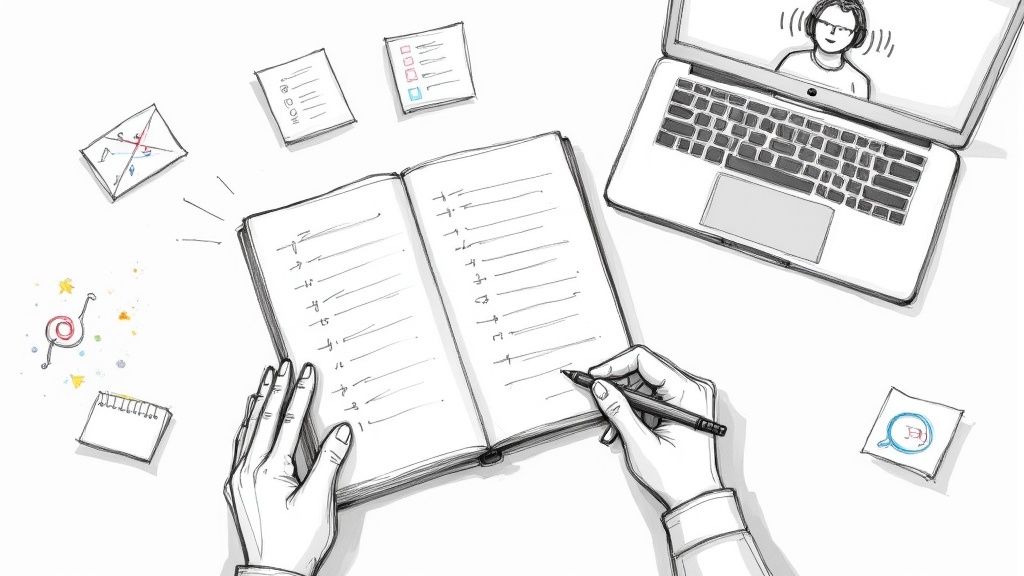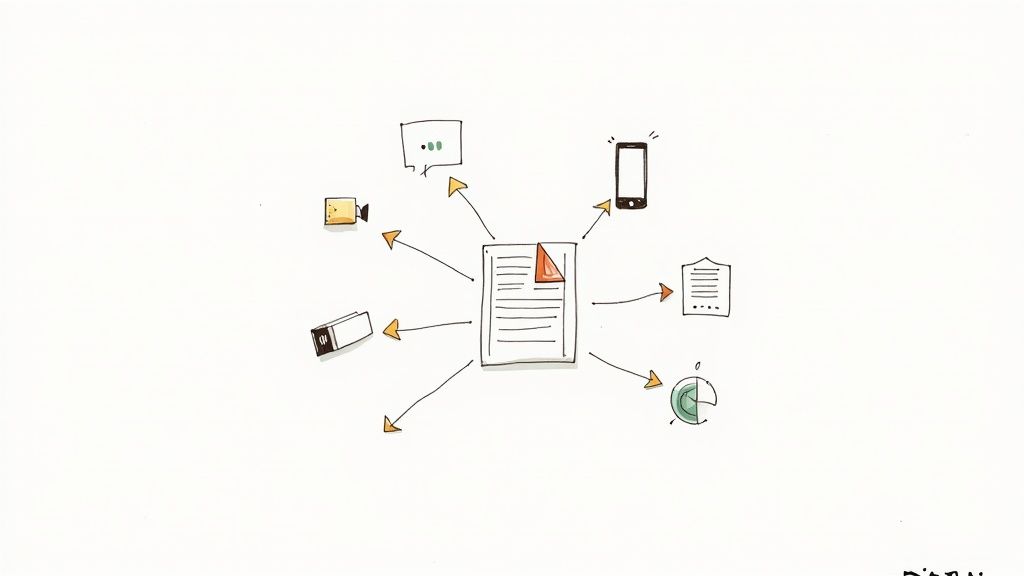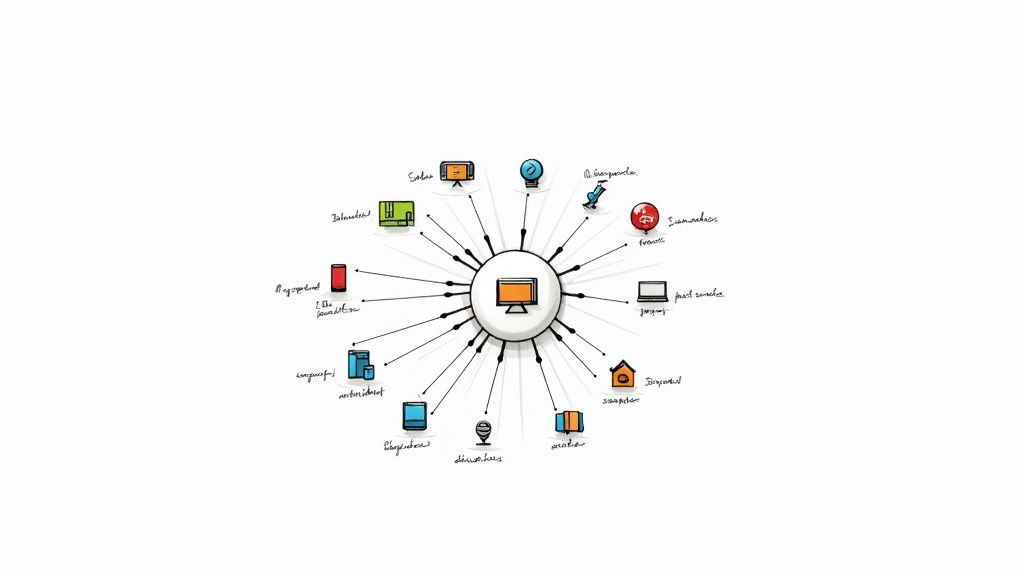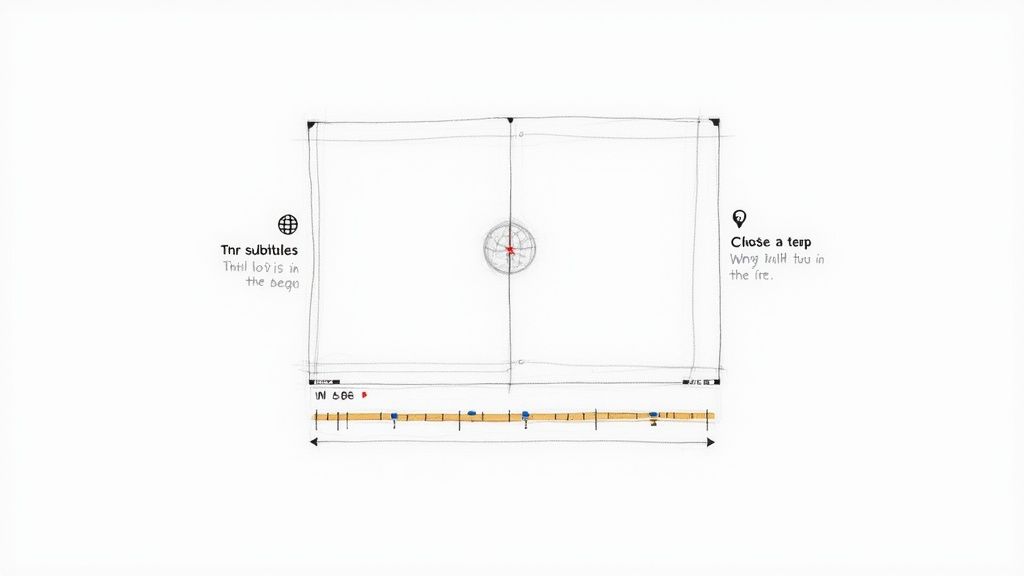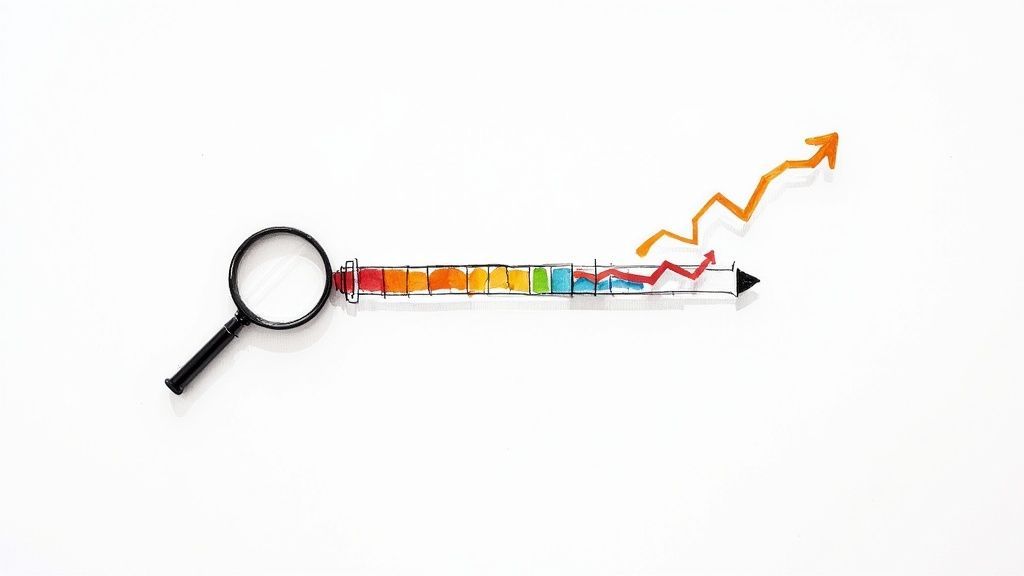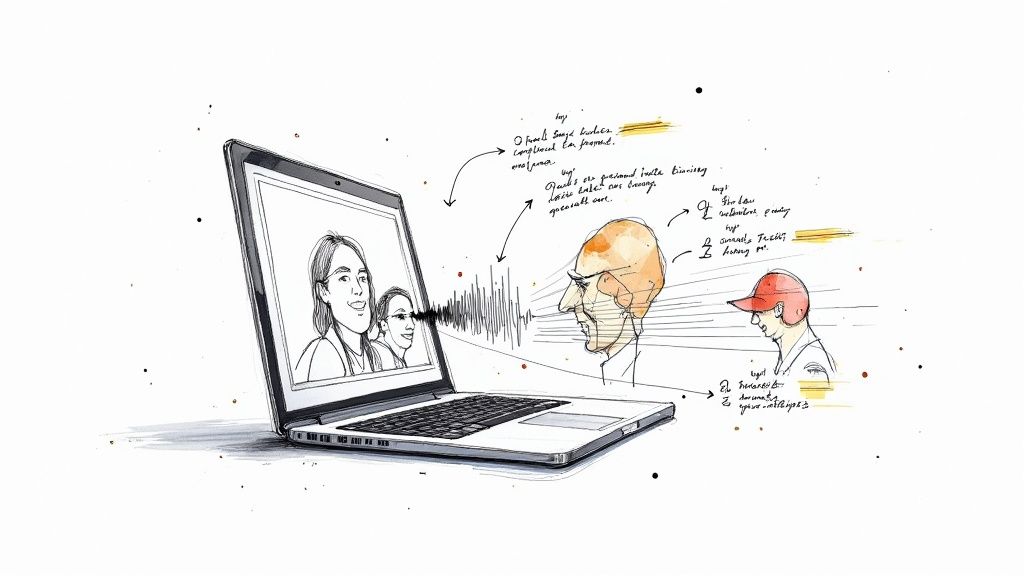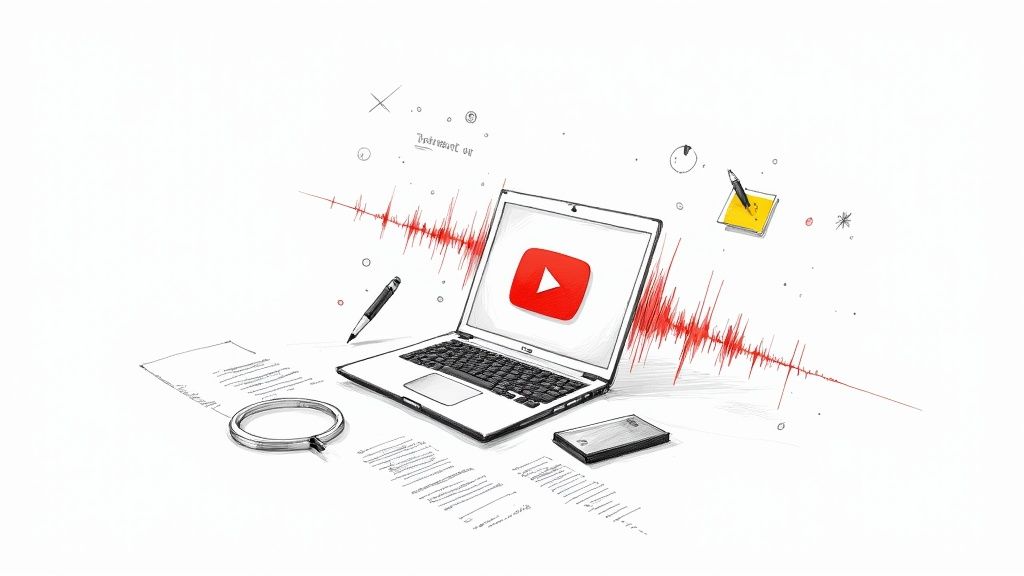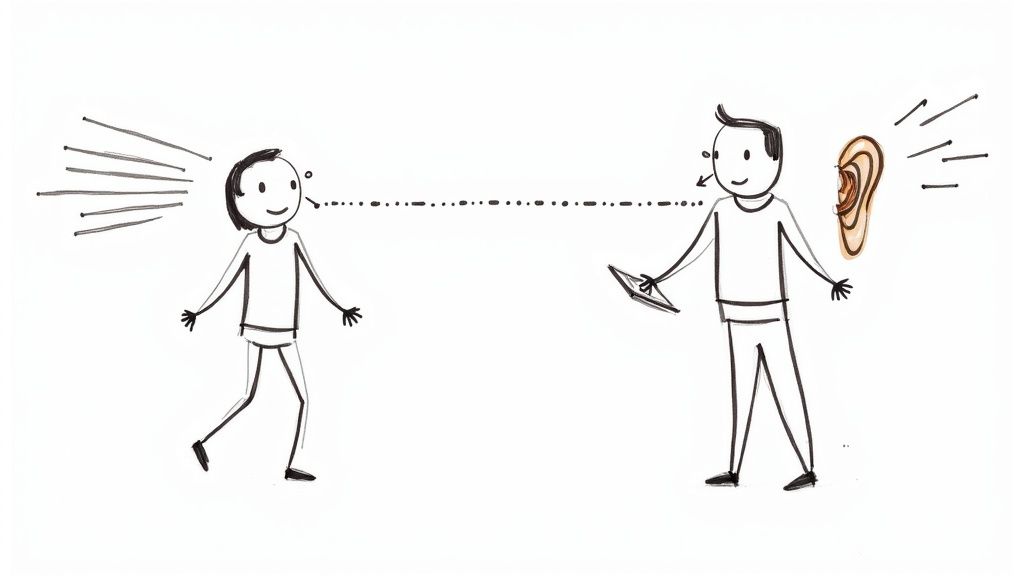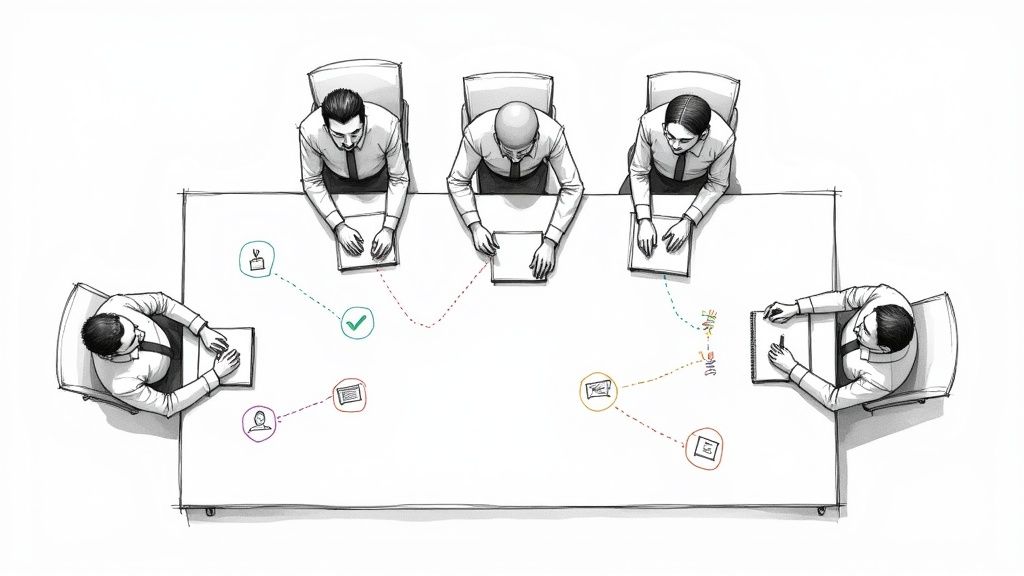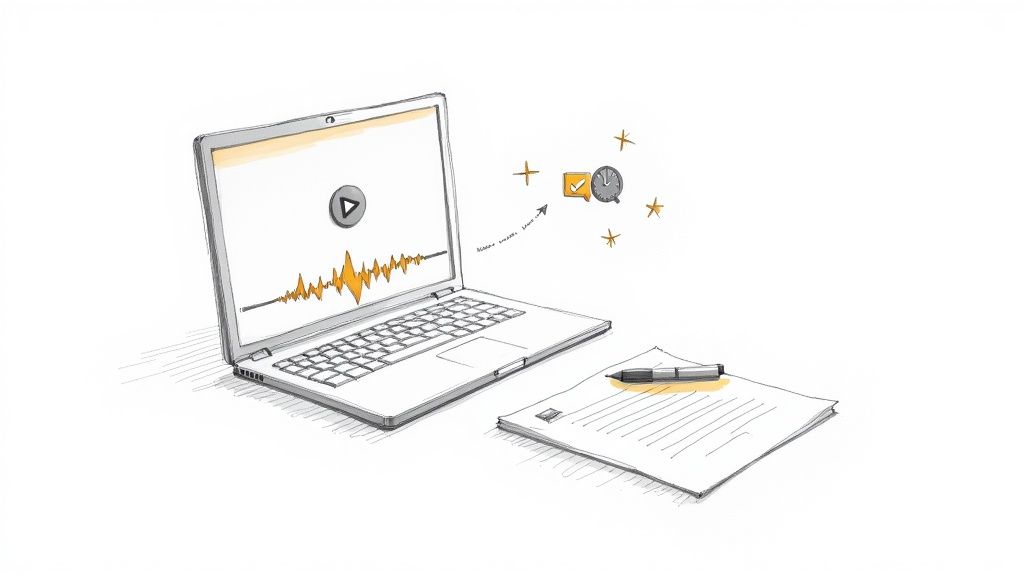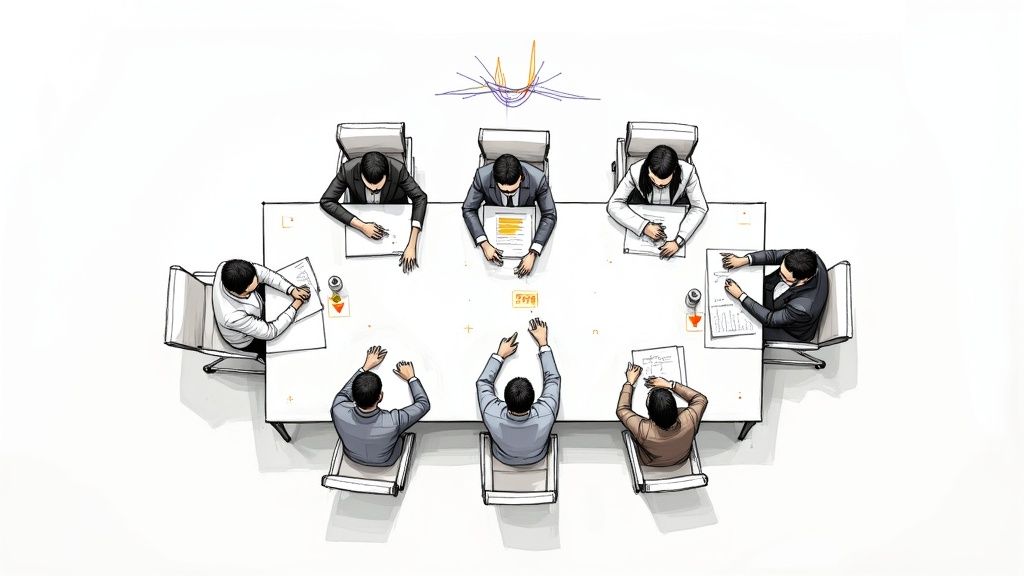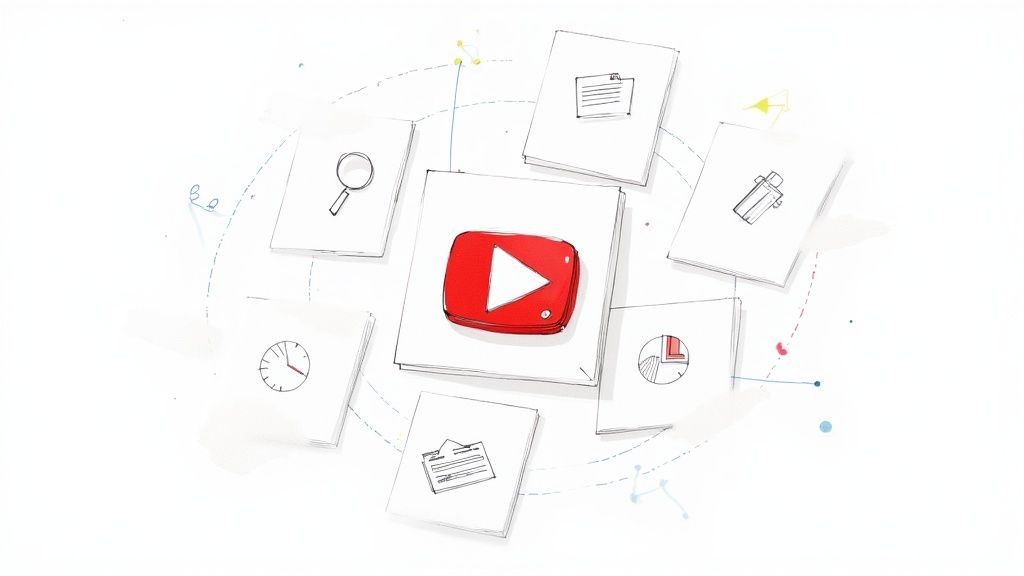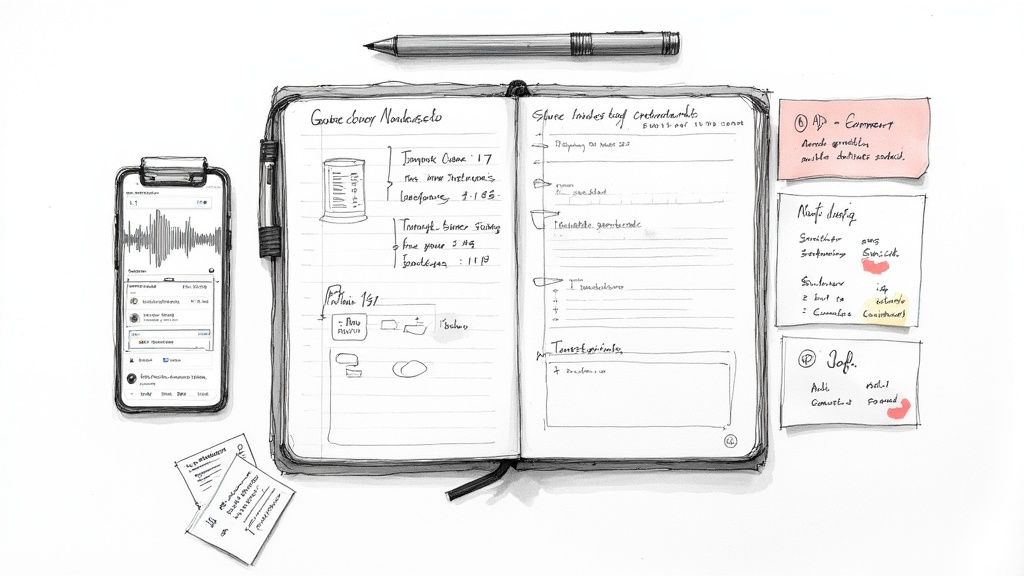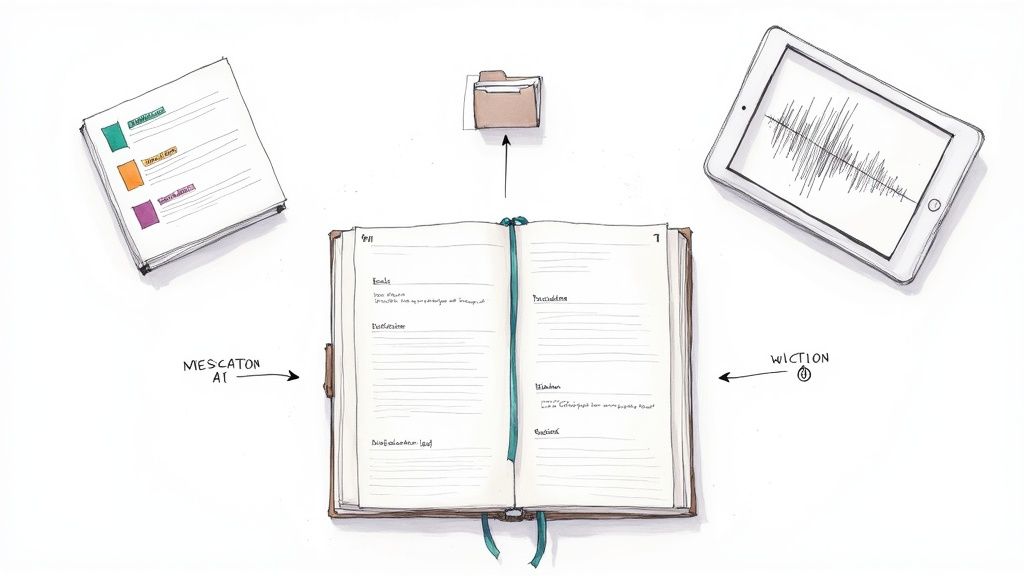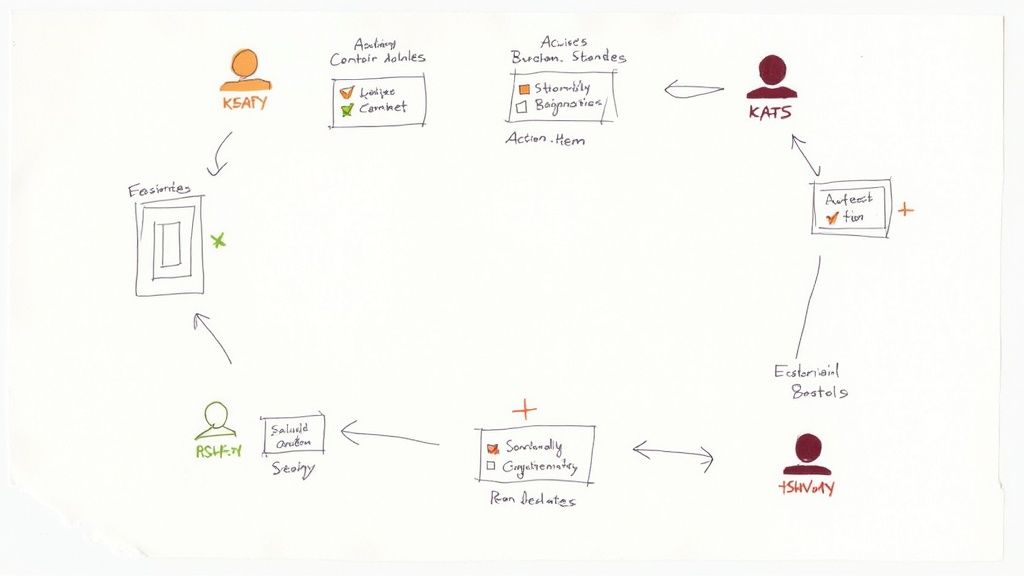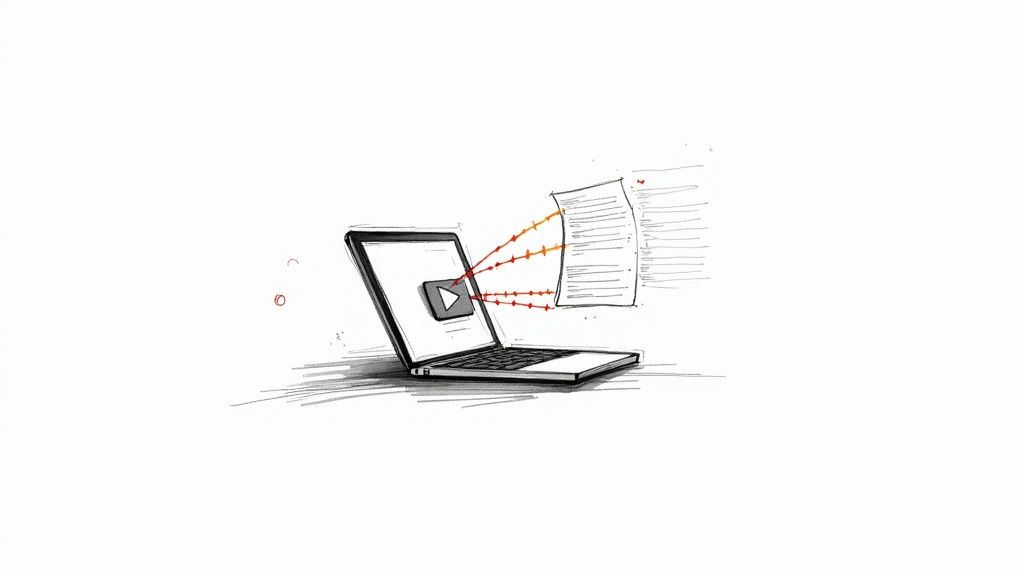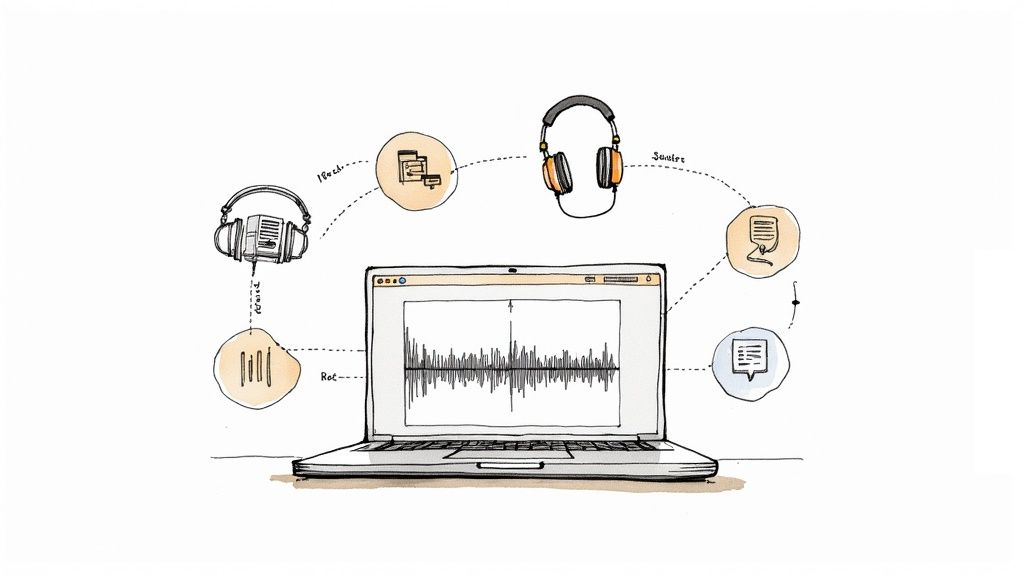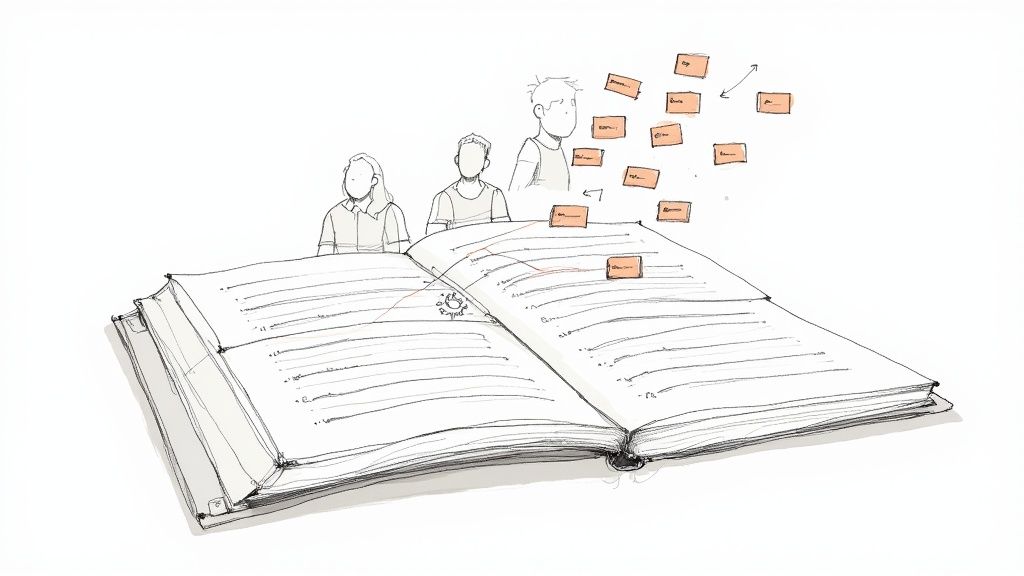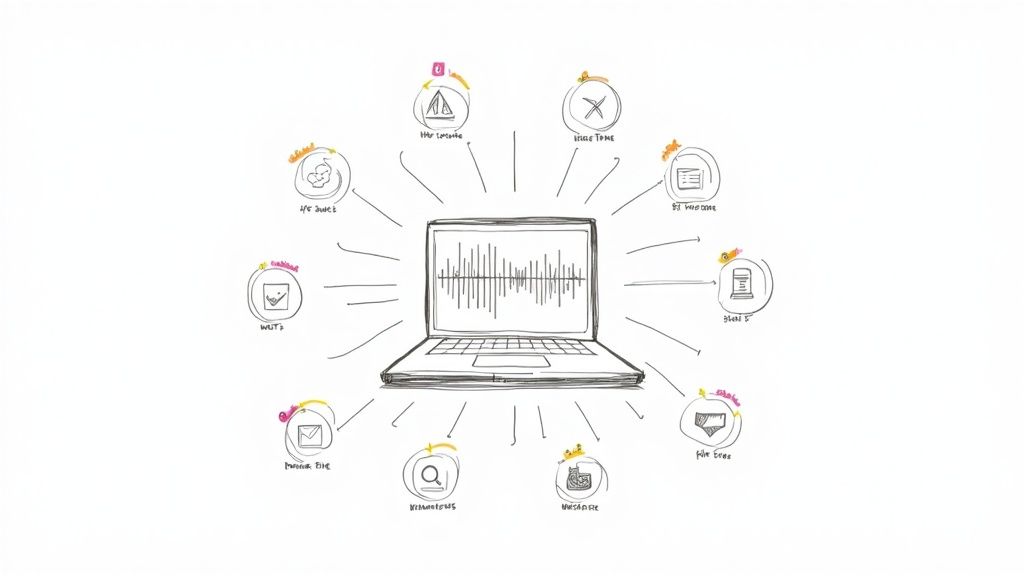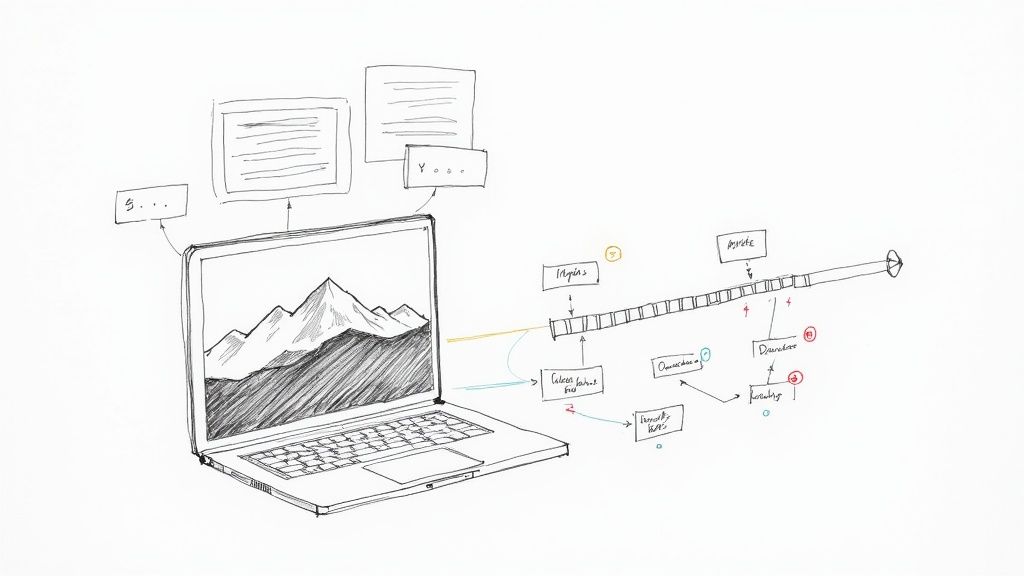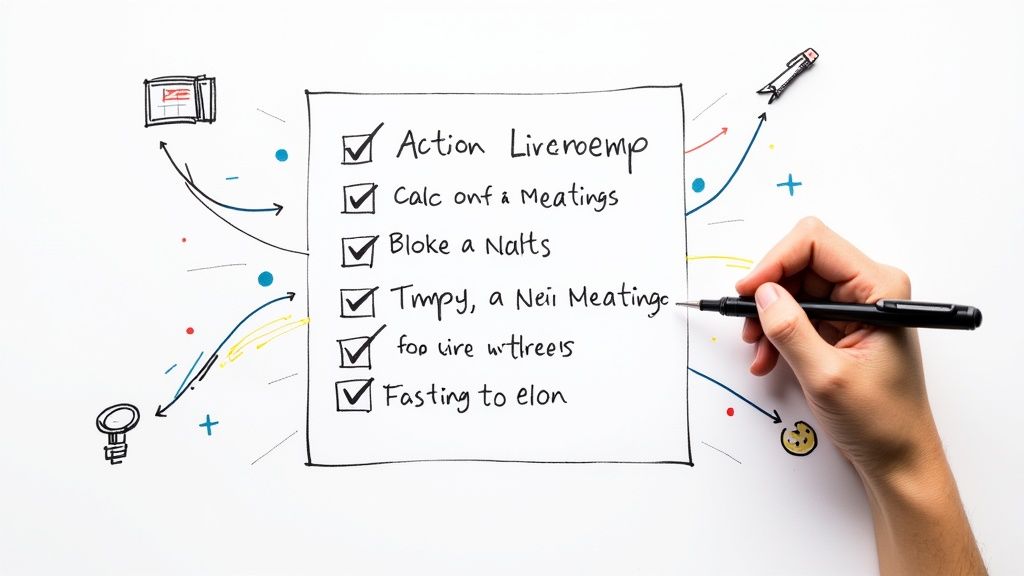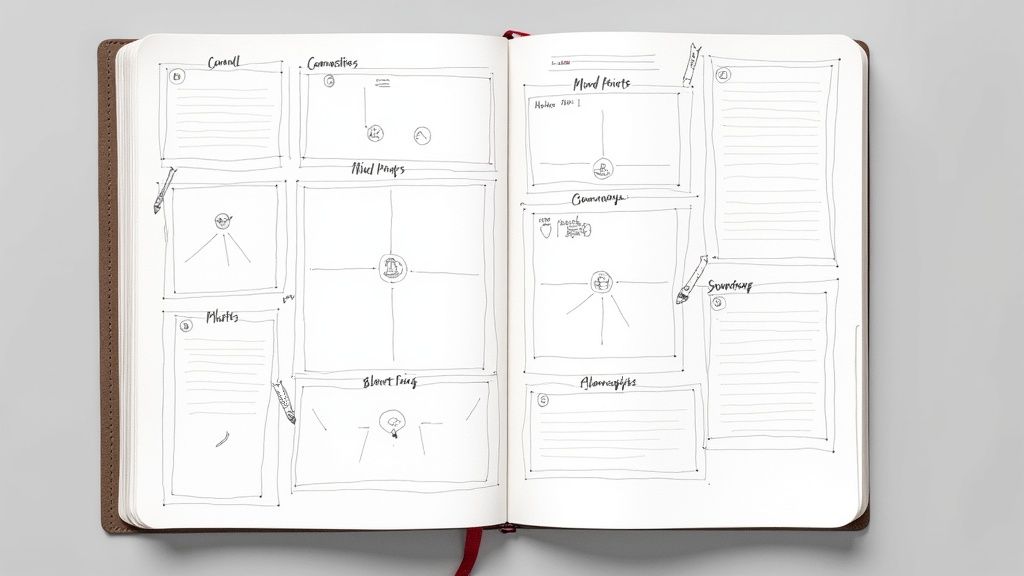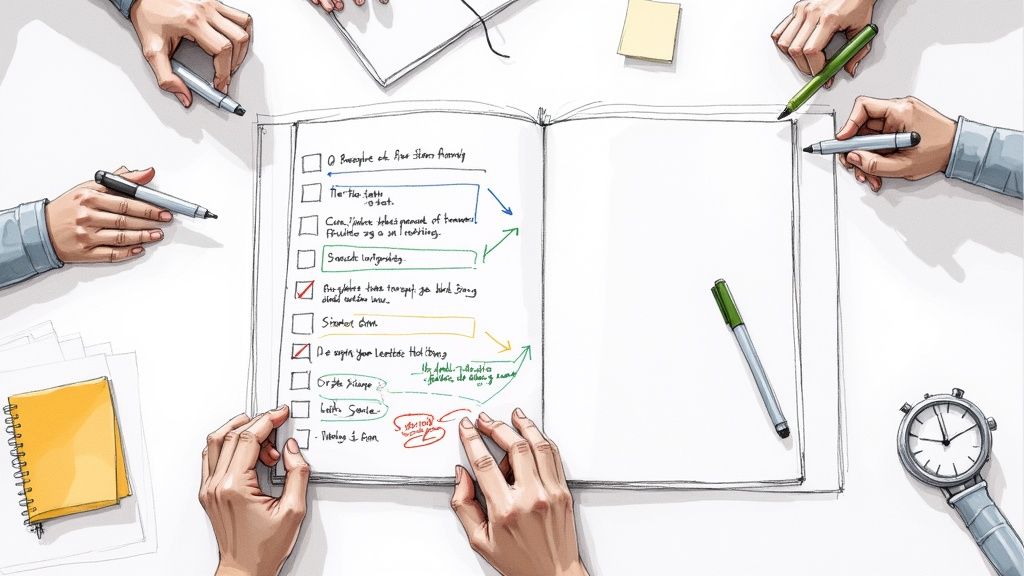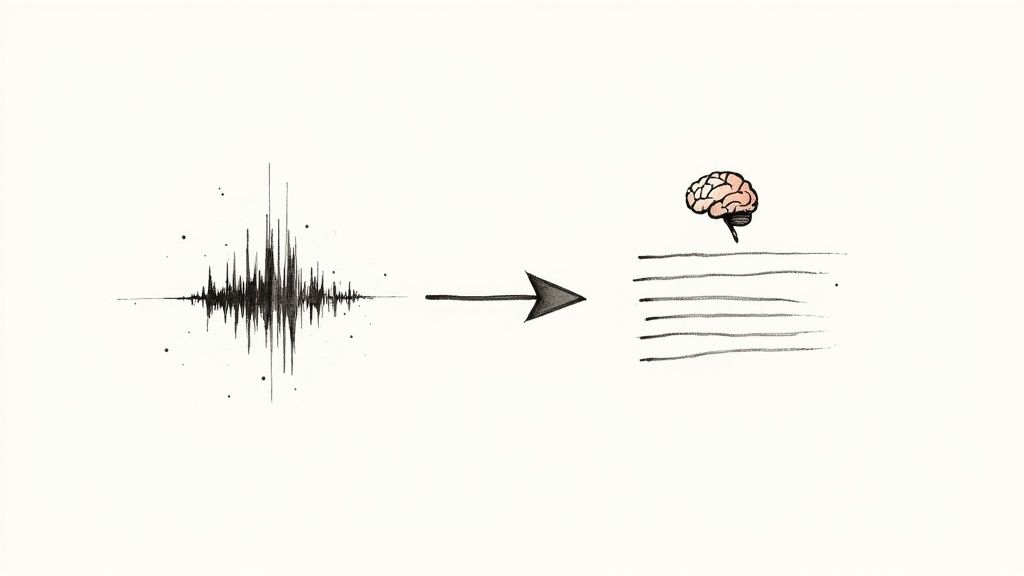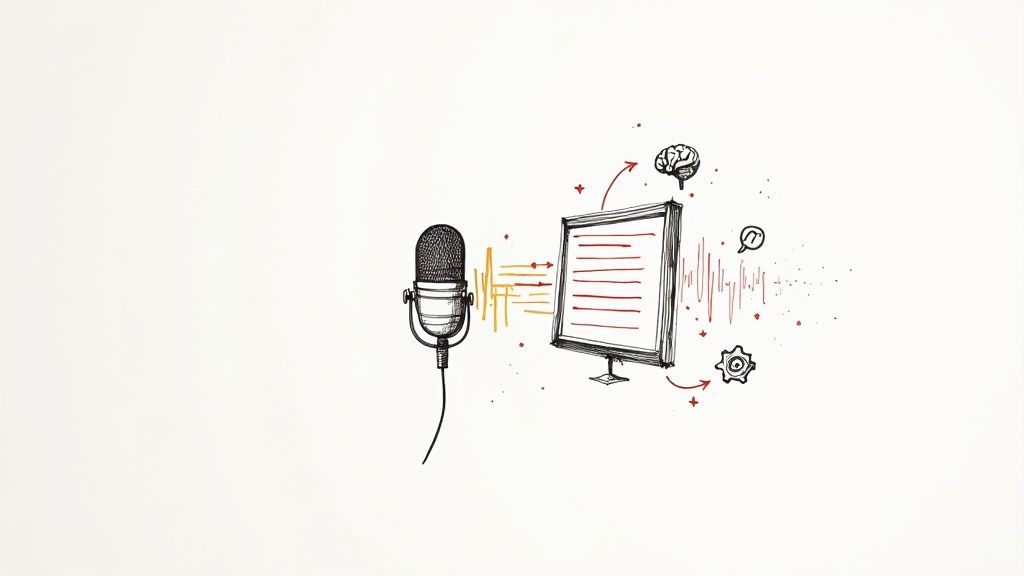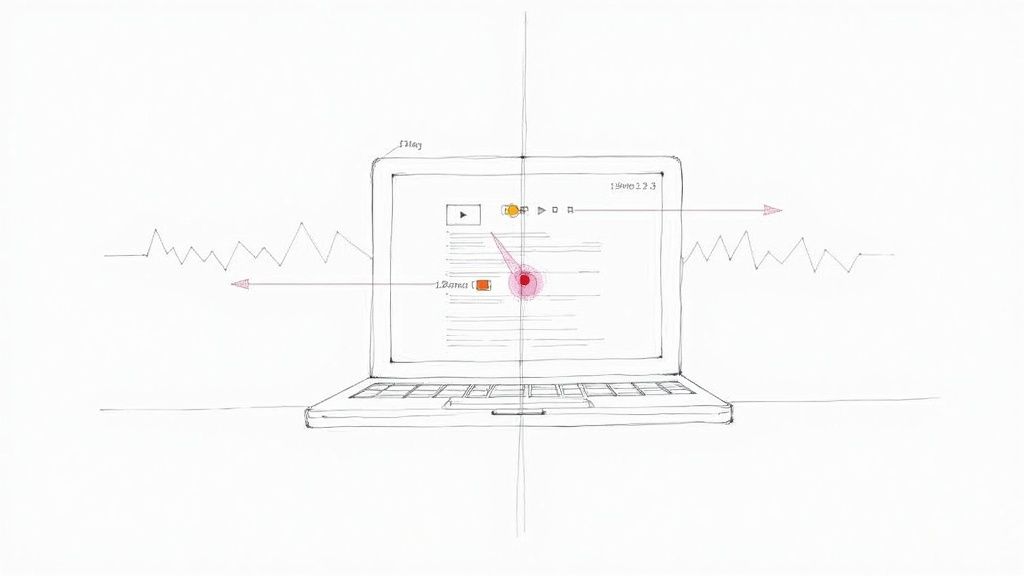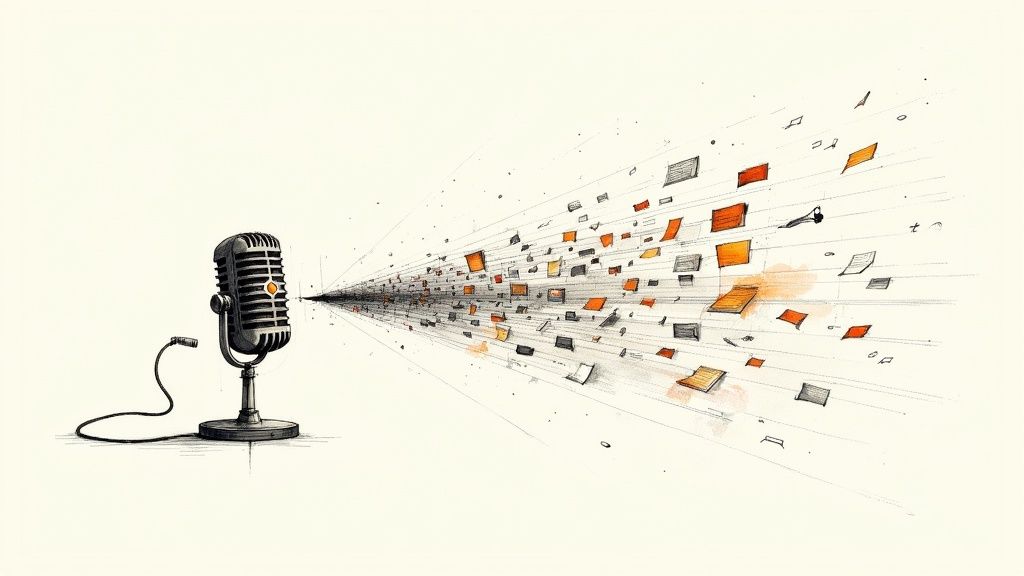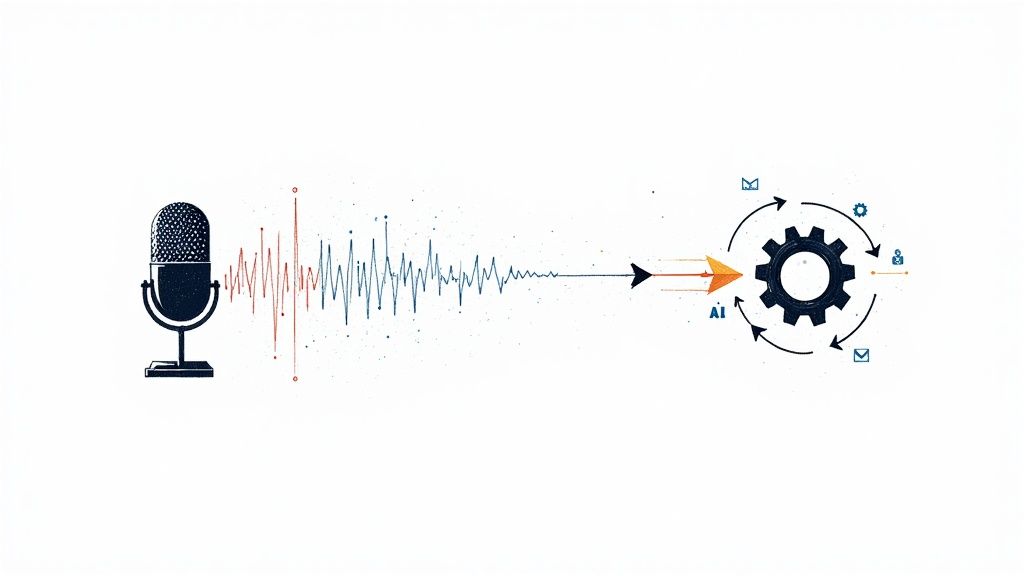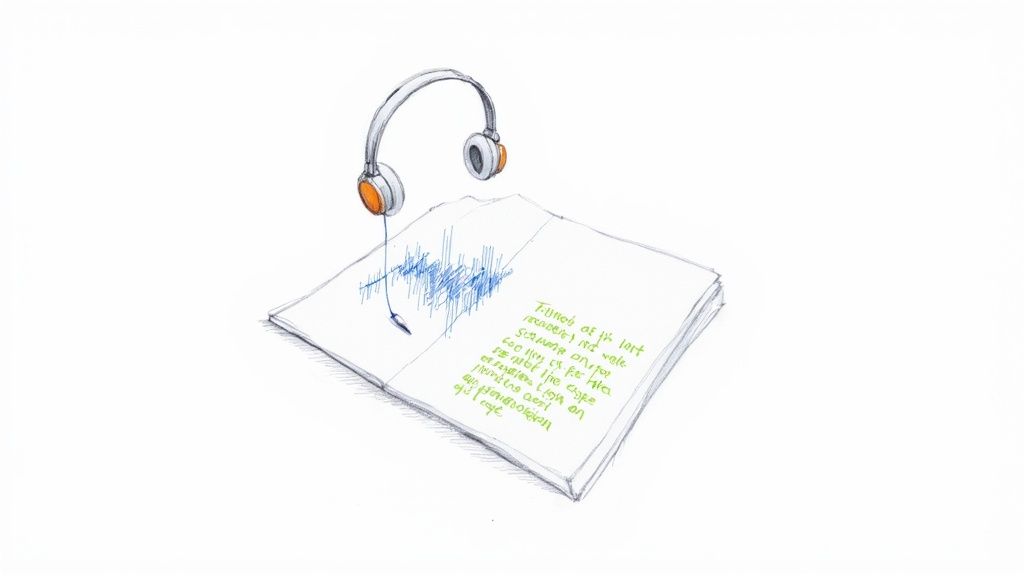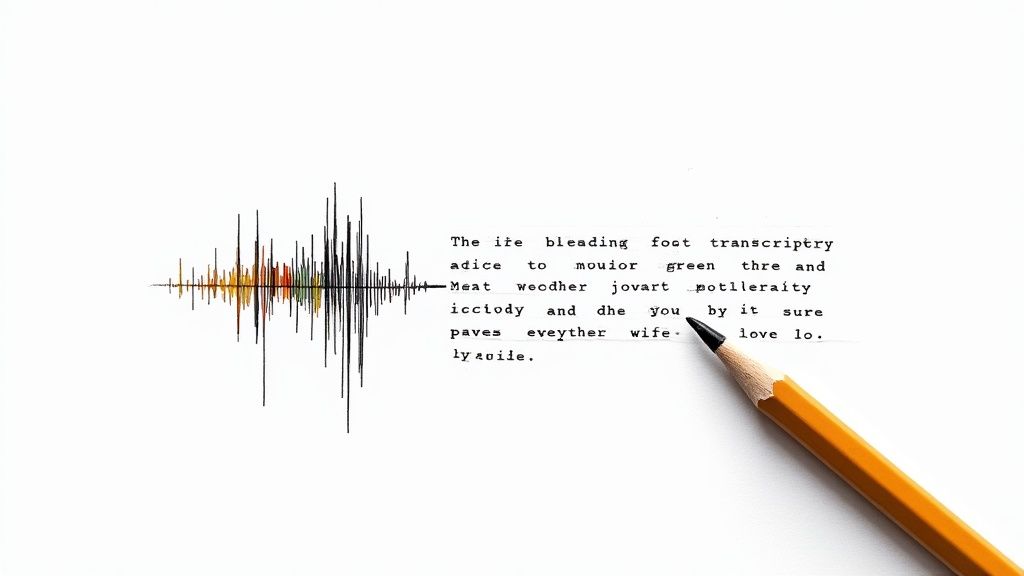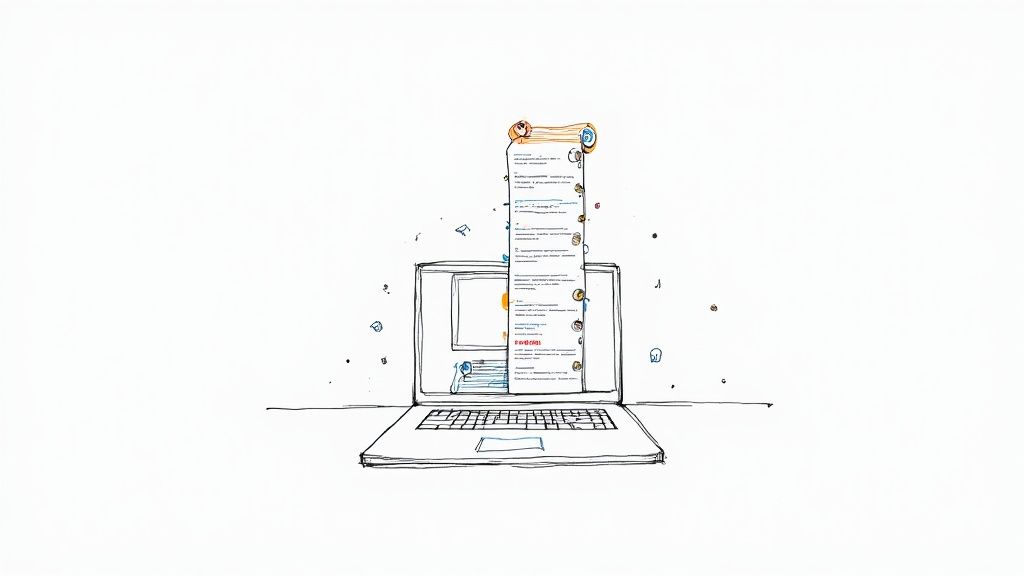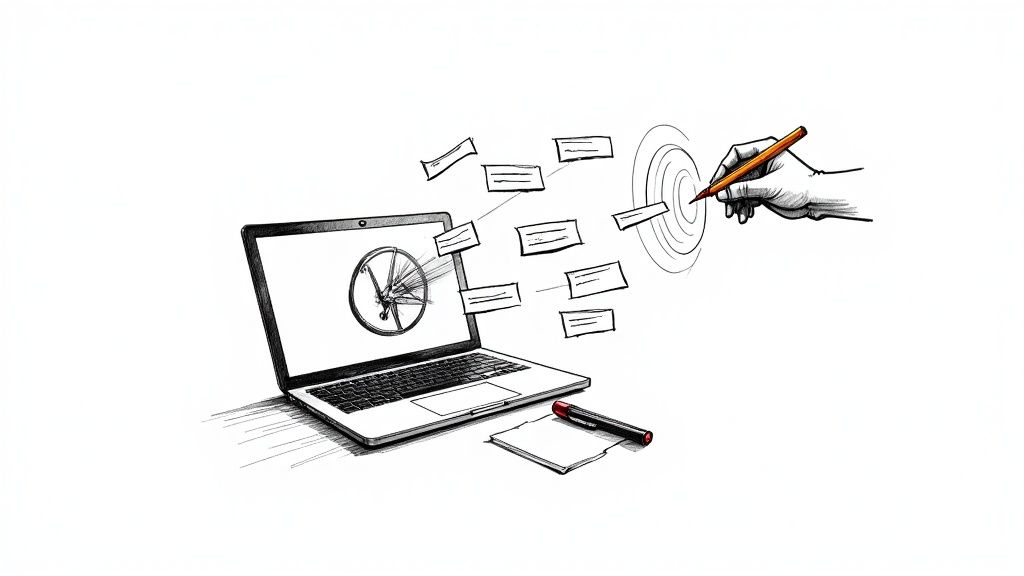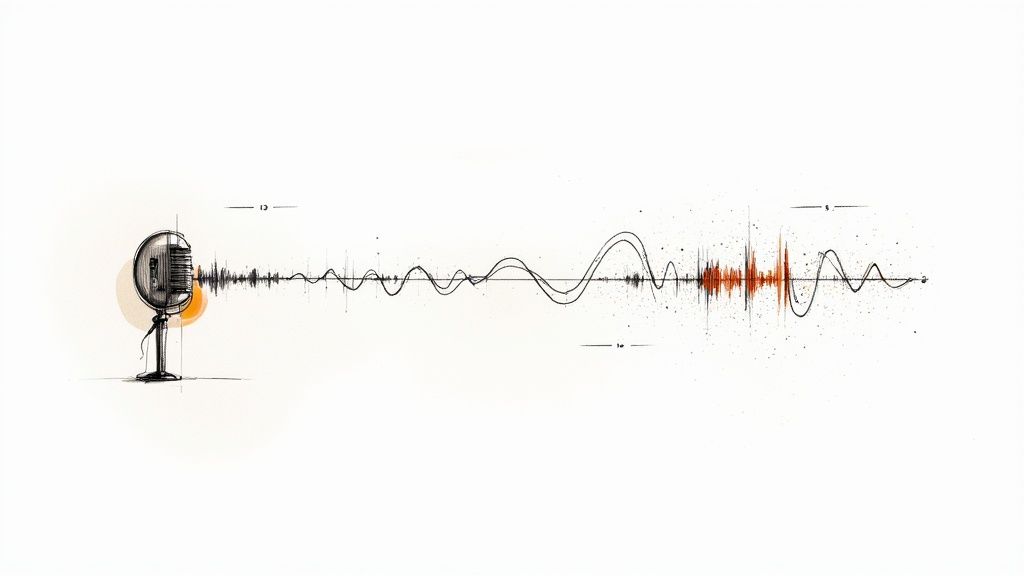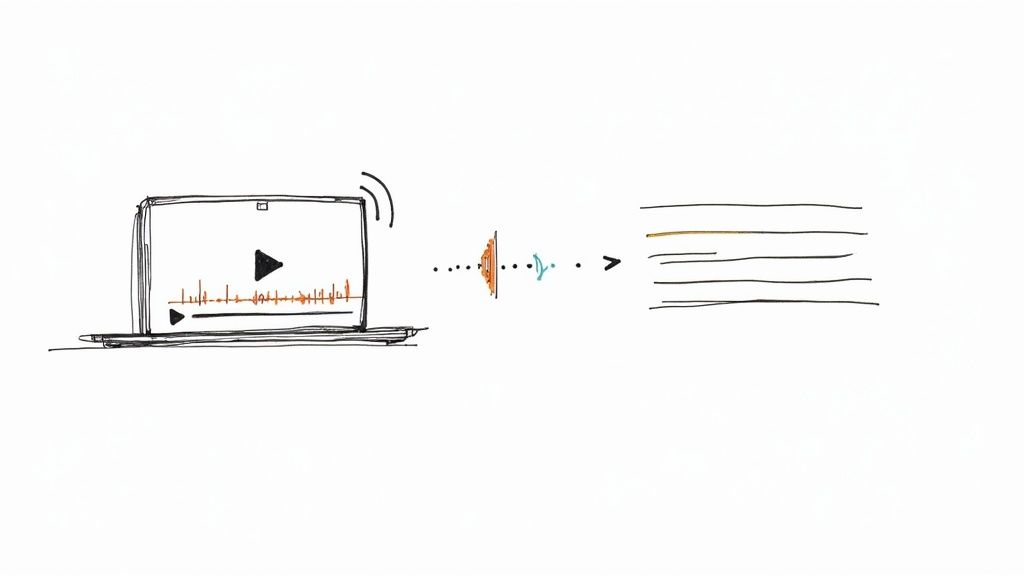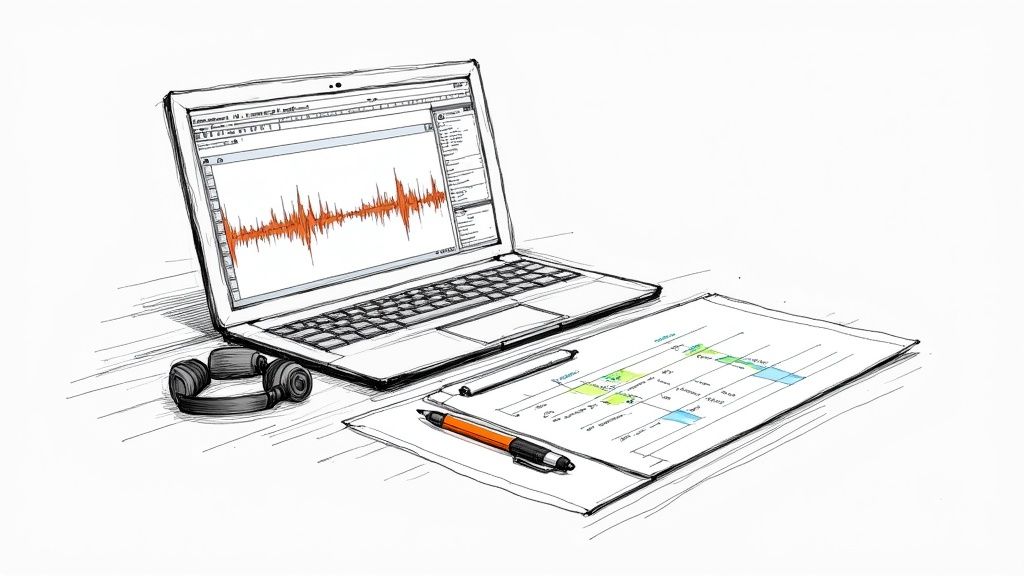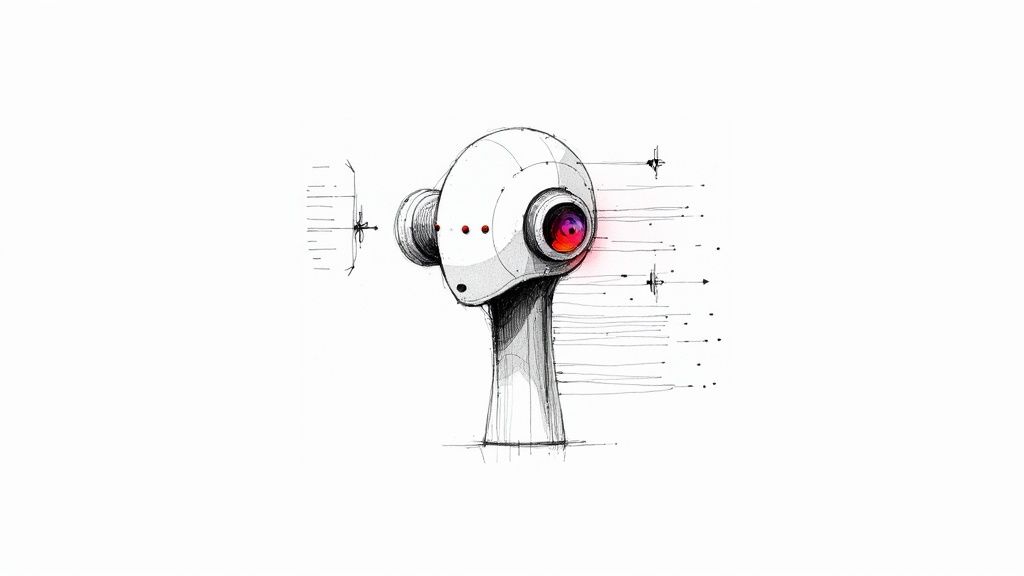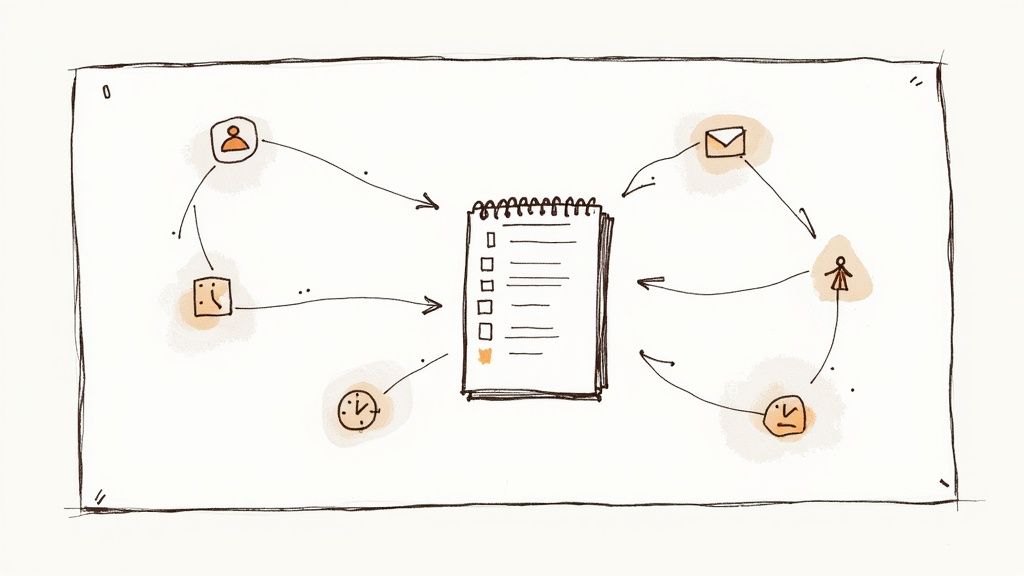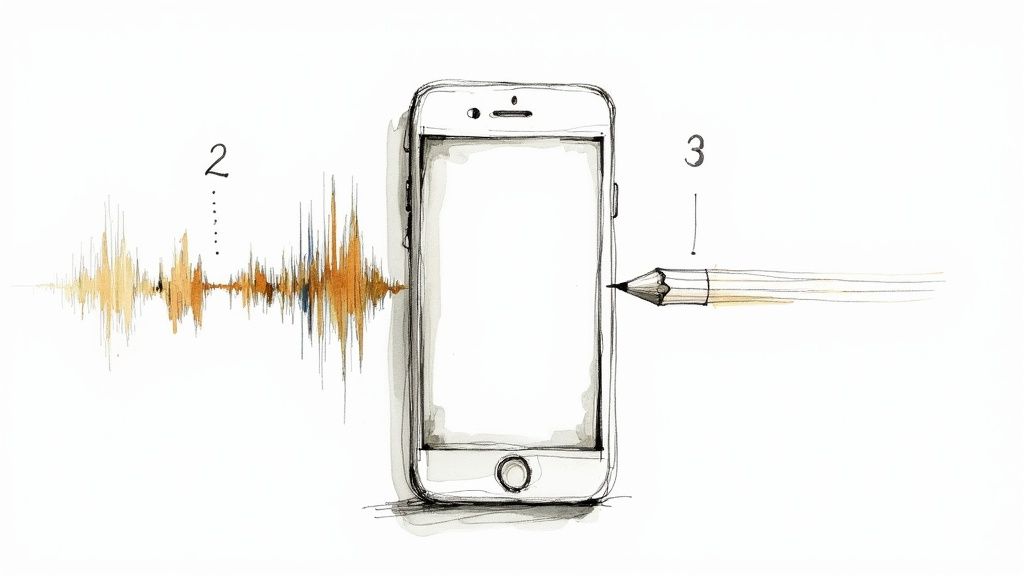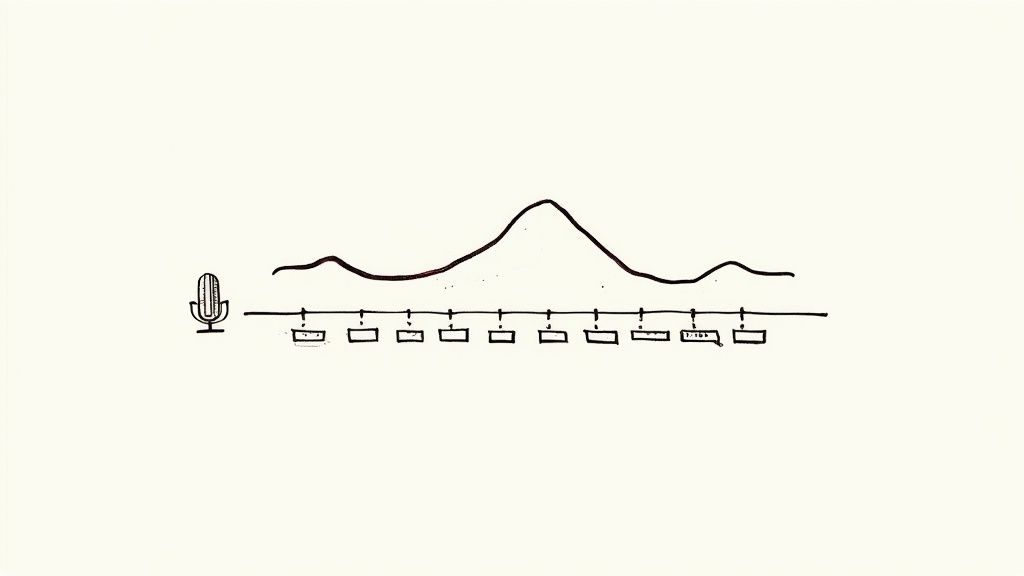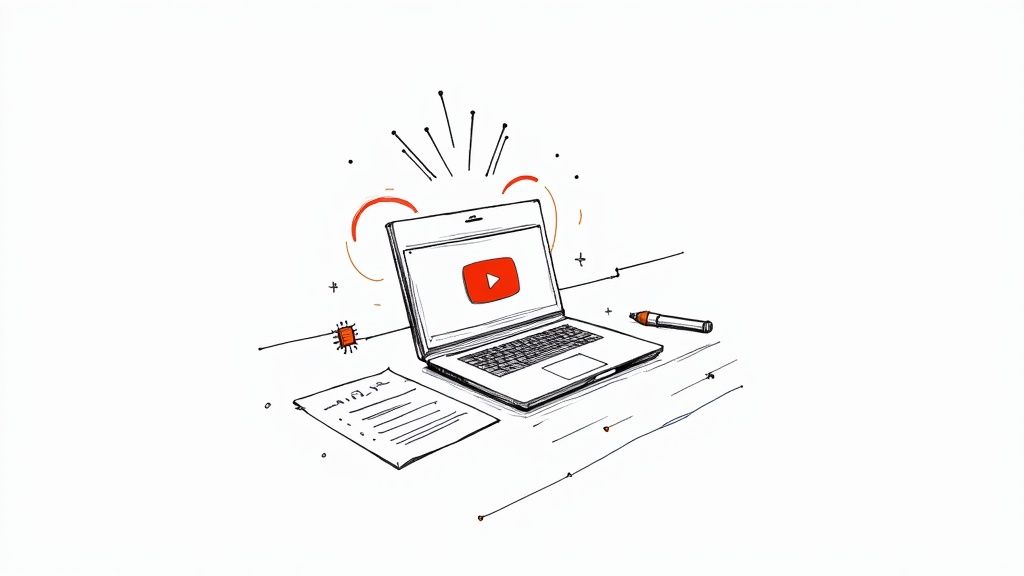
Decoding the Cost of Transcription Services: A Practical Guide
Figuring out how much transcription should cost can feel like a guessing game. Prices swing wildly, from less than $0.25 an audio minute for an automated service to over $5.00 a minute for a human expert handling complex files. So, what should you really expect to pay? The answer boils down to a few key factors: the level of accuracy you need, how quickly you need it back, and the complexity of your audio file.
How Much Do Transcription Services Typically Cost?
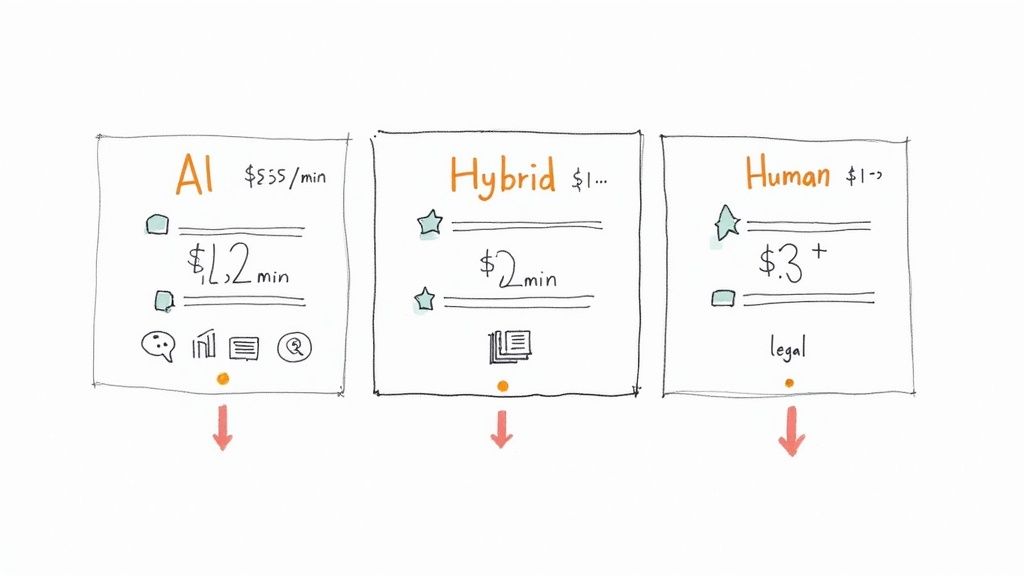
From my experience, the best way to think about transcription costs is to compare them to shipping a package. You can choose the slow, budget-friendly ground option (that’s your AI transcription), or you can pay a premium for white-glove, next-day delivery that guarantees it arrives in perfect condition (that's your specialized human transcriber). Each one gets the job done, but they're built for completely different needs and budgets.
And this isn't a niche service. The U.S. transcription industry reached a valuation of around USD 30.42 billion in 2024, according to research from Grand View Research. That figure is expected to climb as more industries—from legal and medical to media and marketing—rely on turning spoken words into usable text.
This highlights just how vital transcription has become for making sense of audio and video data. To pick the right service without overpaying, you need to understand what separates one pricing tier from another.
A Quick Breakdown of Transcription Costs
To give you a clear lay of the land, I've put together a simple table that breaks down the main service types. This is a great starting point for seeing where your project might fit and what you can expect to pay.
As you can see, the trade-offs are pretty clear. Automated tools are incredibly fast and cheap, but you'll almost always need to do a round of edits to clean up mistakes. For more on this, you can read our deep dive into AI-powered transcription services.
On the other hand, human transcribers deliver nearly flawless transcripts, but that expertise comes at a price. Ultimately, your best choice will always be the one that hits the sweet spot between your budget and your need for accuracy.
Understanding How Services Bill for Transcription

Before you can nail down a budget, you have to understand the different ways companies charge for their work. The pricing model they use can have a huge impact on your final invoice. It's a bit like picking a cell phone plan—some are pay-as-you-go, others are monthly subscriptions, and the right choice really boils down to how you'll use it.
The most common structure you'll encounter is the per-audio-minute model. This is the industry standard for a good reason: it’s straightforward, transparent, and ties the cost directly to the length of your recording. If you have a 30-minute podcast and the rate is $1.50 per minute, the math is simple: it's going to cost you $45. This approach makes getting quotes and comparing different services easy.
But that's not the only way companies charge. While most stick to the per-minute rate, it's smart to know about the other structures you might come across.
Other Billing Structures You Might See
While the per-minute rate is king in the transcription world, a couple of other models pop up now and then, usually for specific types of projects. Knowing what they are helps you understand the full pricing landscape. To get a wider view of how different platforms handle costs, it can be helpful to look into various pricing models across the service industry.
Here are a few alternatives:
- Per-Word Billing: This is much more common for translation or copywriting, but you'll occasionally see it for transcription. The big drawback here is unpredictability. A fast talker can cram a lot more words into a minute than someone who speaks slowly and deliberately, making it tough to estimate your costs upfront.
- Per-Hour Billing: You'll typically find this model when hiring a transcriber for an ongoing project or as a dedicated contractor. They charge for the actual time they spend working, not the length of your audio. This means the difficulty of the file is the biggest cost factor.
A 60-minute interview with perfect, crystal-clear audio might only take a seasoned pro 2-3 hours to transcribe. But if that same 60-minute file is full of background noise, technical jargon, and overlapping speakers, it could easily take 5-6 hours to complete, effectively doubling your cost.
The Rise of Subscription Plans
As AI-driven transcription services have become more popular, so have subscription plans. They offer a fantastic, cost-effective option for anyone with a steady stream of transcription work. It’s the gym membership model of transcription: you pay a flat monthly fee for a set amount of access.
These plans usually give you a bulk number of transcription minutes for a fixed price, which often works out to be much cheaper than paying per minute. For example, a plan might offer 1,200 minutes (20 hours) of transcription each month. This is perfect for podcasters, content marketers, or academic researchers who consistently need audio turned into text.
One thing to watch out for, though, is overage fees. These are the per-minute rates you'll pay if you go beyond your monthly allowance, and they can sometimes be higher than standard pay-as-you-go pricing.
What Factors Influence the Final Transcription Cost?
Ever submitted two audio files of the exact same length but received two very different price quotes? It’s a common scenario, and the answer is that not all audio is created equal. The final price tag for a transcription project often hinges on several key variables that can dramatically increase the time and effort needed to get the job done right.
Think of a transcriber's work like assembling a puzzle. A crystal-clear audio file is like a puzzle with all the pieces neatly laid out. But a messy, complex file? That’s the same puzzle, only now you’ve got missing pieces, blurry images, and a few extra parts from a different box. It’s obvious which one is going to take longer to solve.
The Impact of Poor Audio Quality
The single biggest factor that inflates transcription costs is, without a doubt, poor audio quality. When a transcriber has to strain to hear what’s being said, replaying the same five-second clip over and over, the clock is ticking. That extra time directly impacts your final bill.
So, what makes audio "poor"? It usually comes down to a few common culprits:
- Background Noise: A loud café, rumbling street traffic, or even the subtle hum of an air conditioner can easily drown out spoken words.
- Speaker Distance: If someone is too far from the microphone, their voice becomes faint and muffled, making it a real challenge to decipher.
- Crosstalk: This is a classic problem in group recordings. When multiple people talk over each other, separating their dialogue becomes a painstaking, time-consuming task.
- Heavy Accents: Professional transcribers are skilled with a wide range of accents. However, particularly strong or unfamiliar ones naturally require more concentration and time to transcribe accurately.
Key Takeaway: Providing clean audio is the single most effective way to keep your transcription costs down. A few minutes of prep work before you hit record can save you a surprising amount of money on the backend.
Complexity and Special Requirements
Beyond just audio clarity, the content of the recording and any specific formatting you need play a massive role in the final price. These special requests add layers of complexity that demand more focused work and a higher fee.
One of the most common cost drivers is the number of speakers. A straightforward one-on-one interview is a world away from a focus group with six people chiming in. Telling voices apart, especially when people have similar vocal tones, requires intense focus and often means listening through the file multiple times.
The type of transcript you request also makes a big difference. For instance, strict verbatim transcription—which captures every single sound, including "ums," "ahs," stutters, and false starts—is far more labor-intensive than a standard, clean transcript that edits these out for readability.
Finally, any special formatting will add to the bill. Adding timestamps at regular intervals, for example, is a manual process that takes extra time. If you need timestamps to sync up your transcript with a video, it helps to understand what's involved. You can learn more about how transcription with timecodes works and see why it affects the project scope. This attention to detail is part of a booming industry; the global transcription market is projected to hit USD 31.9 billion by 2025 as demand from medical and business fields continues to climb. For more on this trend, check out this analysis of transcription software statistics.
The Price of Speed
Need it done yesterday? Just like overnight shipping, faster delivery comes at a premium. Turnaround time is a major factor in what you'll pay for transcription. Standard delivery is always the most budget-friendly option. But if you need a transcript back in 24 hours or less, expect to pay a rush fee. This extra charge compensates transcribers for dropping everything to prioritize your project, which often means working outside of normal business hours to meet your deadline.
Choosing Between Human and AI Transcription Services
When you need audio turned into text, you're faced with a fundamental choice: should you use a human expert or a sophisticated algorithm? This decision is about more than just comparing per-minute rates. It's a trade-off between the upfront savings of AI and the hidden cost of your own time spent cleaning up the text later. The best path forward really depends on what you're working on.
Automated transcription has come a long way, offering a seriously fast and affordable way to get words on a page. Think of it as your go-to for a solid first draft. It shines in situations where getting the gist is more important than getting every single word perfect.
When Is AI Transcription the Right Choice?
AI is the hands-down winner when speed and cost are your biggest concerns. It's the perfect tool for jobs where the transcript is more of a reference point than a final, polished document.
I'd recommend using an AI service for things like:
- Whipping up initial drafts of interviews or meetings for your team to review.
- Turning personal notes or voice memos into searchable text.
- Creating rough transcripts of podcasts or videos that you know you'll be editing heavily anyway.
- Quickly sifting through large volumes of audio to find key topics before diving in deeper.
This decision tree can help you see at a glance whether accuracy, speed, or your budget should steer your choice.

As you can see, if you're on a tight budget or need something back right now, an automated service is almost always the right call. For a more detailed look at the process, our complete guide to transcription has you covered.
When Is Human Expertise Worth Paying For?
On the flip side, there are plenty of times when the nuance, context, and near-perfect accuracy only a human can provide are absolutely essential. Yes, the initial cost of transcription services is higher, but a professional saves you the time and headache of proofreading and editing. They deliver a document you can trust and use immediately, making the investment well worth it in high-stakes projects.
Human transcription is critical when even a tiny mistake could have big consequences. You're not just buying typed words; you're investing in understanding, accuracy, and professional judgment.
You should always opt for a human transcriber for:
- Legal Proceedings: Depositions, court hearings, and witness statements require 99%+ accuracy. A single wrong word here could literally change the outcome of a case.
- Medical Records: There's no room for error with patient notes and medical dictations. Precision is a matter of health and safety.
- Academic Research: Qualitative research and detailed interviews depend on a transcript that captures every utterance faithfully to maintain the integrity of the data.
- Broadcast Media: Subtitles, captions, and scripts for TV or film have to be flawless to look professional and ensure accessibility for all viewers.
Human vs Automated Transcription Head-to-Head
To make the choice even clearer, it helps to see the two options side-by-side. Each has its distinct advantages and disadvantages depending on what you value most—be it cost, speed, or quality.
Ultimately, picking between AI and a human is a strategic move. While AI is rapidly finding its place in workflows like AI-powered content automation, human oversight remains the gold standard for quality. By carefully weighing your project's need for accuracy, speed, and budget, you can make a smart choice that delivers the best return on your investment.
Why Specialized Transcription Costs More
https://www.youtube.com/embed/sha6HQWlZdE
Not all audio is created equal, and the same goes for turning that audio into text. While a standard interview might be fairly straightforward, transcribing a legal deposition, a clinical trial recording, or a technical engineering lecture is a completely different ballgame. The higher cost of transcription services for these fields isn't just an arbitrary markup; it reflects a serious level of expertise and responsibility.
Think of it like hiring a mechanic. For a basic oil change, almost any competent technician can get the job done. But if you need to rebuild the engine of a high-performance race car, you're not going to trust just anyone. You need a specialist—someone with years of dedicated training and experience. That kind of expertise rightfully costs more.
It’s All About Deep Domain Knowledge
Specialized transcription demands far more than just a good ear and fast fingers. A medical transcriber has to be fluent in a language dense with complex Latin terms, pharmaceutical names, and specific anatomical references. Likewise, a legal transcriber needs an ironclad understanding of courtroom procedures, legal jargon, and the rigid formatting required for official documents.
This expertise is absolutely essential. A single misplaced word in a patient's medical record could have devastating health consequences. An error in a legal transcript could completely derail a court case. You aren't just paying for words on a page; you're paying for an expert's deep understanding of the subject matter to guarantee total precision.
The investment in specialized transcription is really an investment in accuracy. In high-stakes fields like medicine and law, precision isn't just a nice-to-have—it's the entire foundation.
This need for niche knowledge is fueling huge growth in the market. The global medical transcription software market alone was valued at USD 2.55 billion in 2024 and is projected to skyrocket to USD 8.41 billion by 2032, driven by the expansion of telemedicine and electronic health records. You can discover more insights about the medical transcription market to see how this specialized field is evolving.
Confidentiality and Compliance Are Non-Negotiable
On top of the complex language, specialized fields are almost always dealing with highly sensitive information. This brings a whole other layer of requirements, namely a rock-solid commitment to confidentiality and compliance with regulations like the Health Insurance Portability and Accountability Act (HIPAA) in healthcare.
Providers that serve these industries must have secure systems and thoroughly vetted professionals to protect client data. This isn't a simple process and typically involves:
- Rigorous Vetting: Transcribers usually go through background checks and sign strict non-disclosure agreements (NDAs).
- Secure Platforms: Using encrypted systems for file transfers and storage to prevent any potential data breaches.
- Ongoing Training: Keeping the team current on the latest privacy laws and compliance standards.
These security measures add to a company's overhead, and that cost is naturally reflected in their pricing. When you opt for a specialized service, part of what you’re paying for is the peace of mind that your sensitive information is being handled with the highest level of care and professionalism.
Common Questions About Transcription Costs
Working out the details of transcription pricing always brings up a few practical questions. To help you nail down your budget and pick a service with confidence, here are direct answers to the most common questions.
How Can I Get the Most Accurate Quote for My Project?
To get a precise quote, you need to give the transcription provider as much detail as possible. Think of it like giving a moving company an inventory of your house; the more they know upfront, the more accurate the estimate will be. Be sure to share the exact length of the audio, how many people are speaking, and be upfront about the recording quality—let them know if there's a lot of background noise or if speakers have heavy accents.
You'll also want to specify your deadline and any extras you need, like verbatim transcription. But here’s the single best way to get a solid price: provide a short audio sample. This simple step lets the service give you a firm, reliable quote instead of just a ballpark guess.
What Are the Common Hidden Fees to Watch Out For?
Yes, some services have extra charges that aren't always splashed across their main pricing page. It's smart to know what to look for so you don't get a surprise on your final invoice.
Keep an eye out for potential surcharges for things like:
- Poor Audio Quality: Files with a ton of background noise or muffled speakers almost always cost more because they simply take longer to decipher.
- Multiple Speakers: An interview with two people is one thing, but a focus group with five is another. Transcribing recordings with three or more voices can get complex and often bumps up the rate.
- Timestamps: If you need timestamps dropped in at specific intervals, that’s typically an add-on service.
- Rush Delivery: Need it back in 24 hours or less? Expect to pay a premium for that speed.
Before you commit, always ask for a full cost breakdown. A reputable company will be transparent about its entire pricing structure from the start.
Is It Cheaper to Use a Freelancer or an Agency?
On the surface, a freelancer might quote you a lower per-minute rate, but it's a classic trade-off. Agencies usually have quality control baked into their process, with multi-step proofreading and the infrastructure to handle big projects on tight deadlines. Their entire system is built for consistency and scale.
When you hire a freelancer, all the vetting, project management, and quality assurance falls squarely on your shoulders. For a small, one-off task, a good freelancer can be a fantastic value. But for ongoing, high-stakes work, the reliability and quality assurance of an agency often deliver a much better return in the long run.
Pro Tip: If you're leaning toward a freelancer for a larger project, start them off with a small, paid test file. It’s a small investment that will tell you everything you need to know about their quality and professionalism before you commit to the full project.
How Can I Lower My Transcription Costs?
The most powerful way to save money on transcription is to provide clean, high-quality audio. This is, without a doubt, the number one factor you can control. Record in a quiet room, use a decent microphone, and make sure speakers are reasonably close to it and speaking clearly.
If you can, have each person state their name at the start of the recording—it makes speaker identification much easier. Also, simply choosing a standard turnaround time instead of a rush job will always save you money. For content that doesn't need to be perfect, you could also try a hybrid approach: use an AI service to get a rough first draft, then hire a human editor to clean it up. This can be a lot more budget-friendly than paying for full human transcription from scratch.
Ready to get fast, accurate transcripts without the guesswork? Whisper AI uses advanced AI to turn your audio and video into searchable text in minutes. With support for 92+ languages, automatic speaker detection, and instant summaries, it's the perfect tool for creators, marketers, and researchers. Get started with Whisper AI today and see how easy transcription can be.


